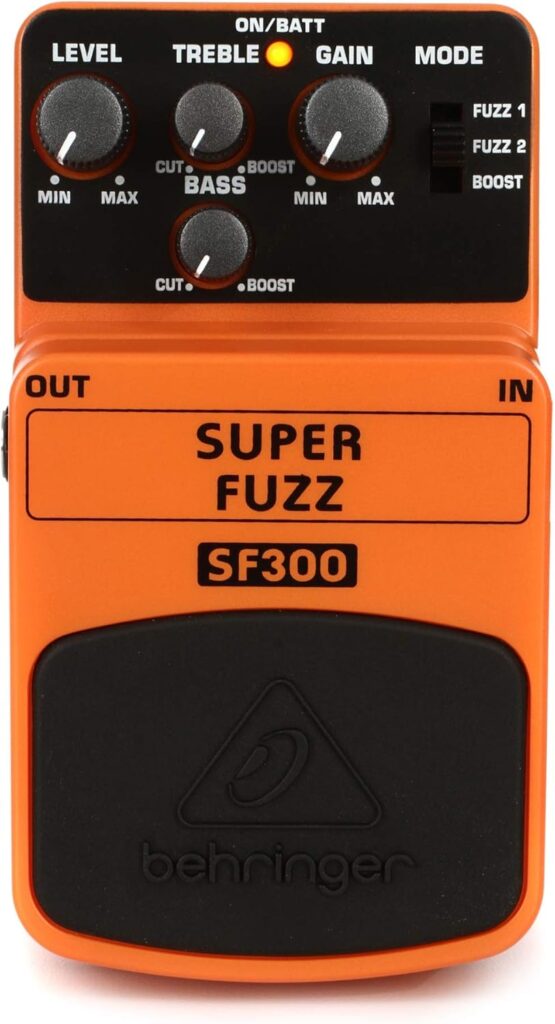Warning: This tiny orange pedal might summon the spirit of doom legends.

If you’ve ever said to yourself, “I want my tone to sound like a fuzzed-out chainsaw being launched into space,” then congrats—you’re the target audience for the Behringer Super Fuzz SF300.
It’s cheap. It’s loud. And it absolutely rips.
But can a sub-$40 pedal actually hang with boutique fuzz boxes that cost five times as much? Spoiler alert: yes, and then some.
Affiliate Disclosure: This post contains affiliate links. We may earn a small commission if you buy through them—at no extra cost to you. That helps keep the fuzz flowing and the coffee strong.
🎸 What Is the SF300, Anyway?
The Behringer SF300 is a wild fuzz/distortion pedal inspired by the Boss FZ-2 Hyper Fuzz—a long-discontinued cult classic used by doom metal bands like Electric Wizard and Sunn O))).
It offers three distinct modes in one little orange stompbox:
- Fuzz 1: Classic vintage fuzz—think garage rock & early Sabbath
- Fuzz 2: Higher gain fuzz with tighter mids—great for stoner/doom/metal
- Boost: Cranks your signal without the fuzz for a fat, dirty clean tone or amp-pusher
This isn’t a polite, vintage-style fuzz. It’s a face-melting, wall-of-sound generator with way more personality than it should have at this price.
🔍 Features at a Glance
- 3 modes: Fuzz 1, Fuzz 2, and Boost
- 2-band EQ: Shape your highs and lows
- Level & Gain knobs for output and fuzz intensity
- Plastic housing (but surprisingly tough)
- Powered by 9V battery or standard power supply
🔊 How Does It Sound?
Let’s get straight to it: this thing is a beast.
- Fuzz 1 gives you a sludgy, vintage buzz—perfect for 60s garage, grunge, and doom.
- Fuzz 2 goes full scorched-earth with scooped mids, thick lows, and a wall of gain.
- Boost mode lets you slam your amp with clean(ish) gain—great for driving tubes or stacking with overdrive pedals.
It’s not subtle. It’s not refined. It’s glorious sonic chaos, and if you’re into that, this is your pedal.
🎛 Controls & Usability
The layout is dead simple:
- Level – Your output volume
- Gain – Controls the fuzz intensity
- Treble & Bass – 2-band EQ for tone shaping
- Mode switch – Choose between Fuzz 1, Fuzz 2, or Boost
Despite the plastic build, the knobs are firm and responsive, and the EQ actually does a good job of fine-tuning the mayhem.
🧱 Build Quality
Okay, real talk: the housing is plastic, not metal. But it’s solid enough for home and rehearsal use. If you’re gigging hard or stomping like a T-Rex, maybe be gentle—or toss it on a pedalboard and leave it there.
But considering the price? It’s a non-issue.
🎯 Who’s This For?
- Doom, stoner, grunge, and garage rock players
- Anyone chasing Boss FZ-2 tones on a budget
- Fuzz pedal collectors who want something wild and weird
- Players looking for a boost or dirt pedal under $40
👎 What Could Be Better?
- Plastic casing may not survive a mosh pit
- No true bypass (some tone coloration when off, though not a deal-breaker)
- It’s not a versatile all-genre pedal—it’s built for mayhem, not jazz brunch
✅ Final Verdict: Is the Behringer SF300 Worth It?
For the price of a pizza, you get a fuzz monster with three voices, killer tone, and enough volume to rattle your fillings.
It’s not subtle. It’s not for everybody. But if you love aggressive fuzz, and you’re not ready to drop $200 on a boutique clone, this is a no-brainer.
🎸 👉 Check Current Price on Amazon
🔥 Pros & Cons Recap
Pros:
- 3-in-1 fuzz/boost tones
- Legendary FZ-2-inspired sound
- Two-band EQ for tone shaping
- Dirt cheap (in price, not sound)
- Great for doom, stoner, and garage tones
Cons:
- Plastic enclosure
- No true bypass
- Might make you start a doom band
Leave a Reply